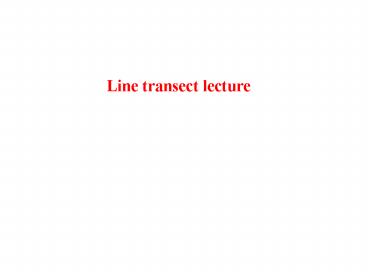Line transect lecture - PowerPoint PPT Presentation
Title:
Line transect lecture
Description:
Duck transects along roads (N. Dakota) Example 1: UK ... Red-tailed hawks. Short-eared owls. Example 2: Raptor Census - Kyle Elliott (2002) and the ... – PowerPoint PPT presentation
Number of Views:239
Avg rating:3.0/5.0
Title: Line transect lecture
1
Line transect lecture
2
Vegetation transects (Offwell, UK)
Coastal fauna Transects (West-central Florida)
Duck transects along roads (N. Dakota)
3
Example 1 UK Butterfly monitoring scheme
4
Example 2 Raptor Census - Kyle Elliott (2002)
and the Vancouver Natural History Society
Bald eagles
Short-eared owls
Red-tailed hawks
5
Q1. Why transects, not always quadrats? Q2. What
are potential biases in method?
6
Animals (in particular) detection bias
7
Animals (in particular) detection bias
8
Example VNHS Raptor census (Elliott, 2002)
9
- Two general methods (see Krebs)
- Distance from random point to organism.
- 2. Distance from randomly selected organism to
neighbouring organism.
2
1
10
- Two general methods (see Krebs)
- Distance from random point to organism.
nearest
Area of circle (p r 2) contains one individual
Inverse of Density individuals per unit area
r
11
- Two general methods (see Krebs)
- Distance from random point to organism.
All methods calculate area per individual for
each circle, calculate mean area per indiv.,
invert
n p sum (r2)
r
byth-ripley
r
r
12
- Two general methods (see Krebs)
- Distance from random point to organism.
If look at third closest organism, we are
calculating area per three organisms, or if
divide by three, mean area per organism (n 3).
3n - 1 p sum (r2)
r
ordered distance
r
r
13
- Two general methods (see Krebs)
- Distance from random point to organism.
- 2. Distance from randomly selected organism to
neighbouring organism.
2
1
14
- Two general methods (see Krebs)
- 2. Distance from randomly selected organism to
neighbouring organism.
Area per two individuals, but two circles
cancels out to same p r 2 formula as before
r
15
- Two general methods (see Krebs)
- 2. Distance from randomly selected organism to
neighbouring organism.
Area per two individuals, but two circles
cancels out to same p r 2 formula as before
r
n p sum (r2)
byth-ripley
16
- Two general methods (see Krebs)
- 2. Distance from randomly selected organism to
neighbouring organism.
Problem how to randomly select first
individual? Nearest organism to a random point
BIASED
Never selected
Frequently selected
17
- WAYS TO RESOLVE PROBLEM
- Mark all organisms with a number, and then
randomly select a few.
BUT if we could count all organisms, we wouldnt
need a census!
18
- WAYS TO RESOLVE PROBLEM
- Mark all organisms with a number, and then
randomly select a few. - Use a random subset of the area (mark organisms
in random quadrats).
Byth and Ripley
19
- WAYS TO RESOLVE PROBLEM
- Mark all organisms with a number, and then
randomly select a few. - Use a random subset of the area (mark organisms
in random quadrats). - Use a random point to locate organisms, but then
ignore area between it and quadrat (biased to
emptiness).
T-square
20
Dartboard analogy for precision/ accuracy
True value
Accurate but not precise
Precise but not accurate
21
Spatial pattern
More uniform
More aggregated
Random
22
- Line transect lab next Monday
- How will we distribute students among transects?
- Expect cold weather and rain. Dress
appropriately. - How will you record your data? In the rain?































